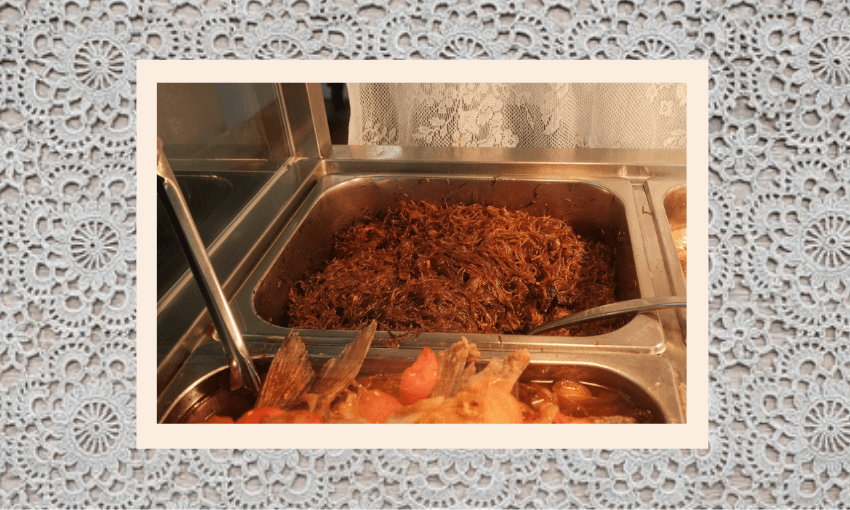Many of Sāmoa’s beloved dishes are the result of cultural collaboration, writes Madeleine Chapman.
All photos by Jin Fellet
If you ever find yourself at a barbecue in a Sāmoan home, there’s 99% chance that sapasui (chop suey) will be on the table. For the past century, sapasui has been a staple dish from the island, even rising to the status of being considered “traditional” and a national dish. Alongside the sapasui on the table, you could expect to see an assortment of other traditional dishes including oka (raw fish in coconut cream), keke pua’a (pork buns) and keke saiga (savoury biscuits). All dishes have few ingredients, utilise flavours commonly grown and found in Sāmoa, and share one special ingredient.
They’re all Chinese.
The story of how Sāmoa’s national palate came to be shaped by Chinese cuisine stretches back the early 20th century, when the first wave of indentured labourers arrived in Sāmoa from southern China. Until then, families and villages grew a large portion of the food they ate on their own land. Meat and vegetables were cooked and served whole, alongside each other, and seasonings were few and far between. Fish was caught and cooked.
Indentured labourers were sought to work the growing plantations across Sāmoa, and Chinese workers were considered the best option. In the Fukien and Guangdong provinces, men facing famine and unemployment saw posters promising luxury and women – both Sāmoan and Chinese – on this faraway island.
When the first shipment of labourers arrived in 1903, they were greeted instead with 11-hour workdays, legal flogging and cut wages. Living in Sāmoa was not at all what they had hoped for, and to make it worse, the food was bland. Enter: a marriage of cuisines.
The men arriving from China brought with them their labour, yes, but also their knowledge of cooking and flavours and some of their own ingredients.
While ginger and garlic might be staple ingredients in New Zealand households today, and have been part of Asian cuisines for thousands of years, in Sāmoa in the early 20th century, they were a novelty. As well as ginger and garlic, Chinese staples like rice and noodles were introduced by the labourers, resulting in simple dishes like chow mein becoming hugely popular.
But unlike the many instances throughout history where countries have simply adopted immigrant cuisines alongside their own, sapasui and Sāmoan cuisine is a genuine collaboration of Sāmoan and Chinese flavours to create something distinct. Due to the limited resources and ingredients available, Chinese couldn’t simply recreate their home dishes in another country.
Chop suey is a true bicultural dish, taking the textures and (some) flavours of Chinese cuisine and fitting them into the existing cooking methods and simple ingredients of Sāmoa. With just six ingredients and a preparation time of 20 minutes (at most) in a single pot, chop suey found the common ground between Sāmoa and China and is a culinary evolution that has stood the test of time.
As Sharon Lam has previously written, such a collaborative approach is hard to find in New Zealand. While Chinese food is often prepared and sold alongside local dishes at takeaway shops, there is no singular dish that illustrates the Chinese-New Zealand relationship like chop suey.
And it’s not alone in its bicultural distinction. Oka – raw fish and vegetables in coconut milk – is an evolution of cooked fish in coconut milk after the Chinese introduced Sāmoans to raw fish. Keke pua’a are a variation on the traditional char siu bao, with a denser dough and adjusted meat filling. And given the savoury palate in Sāmoa, the “sweet” dessert of kekesaiga is in fact a garlic and soy sauce biscuit closer in taste to a dense cracker.
In total, 6,900 Chinese labourers worked in Sāmoa between 1903 and 1934. They married Sāmoan women and fully assimilated (out of necessity) into Sāmoan society. They brought their own knowledge and skills which were integrated into Sāmoan culture, and being all men, they brought their names to a small population, resulting in large Sāmoan family lines with Chinese surnames now.
In 1930, after three decades of questionable treatment of indentured labourers in Sāmoa, the New Zealand administration ordered all indentured labourers to be repatriated back to China. Two decades later, only 174 men remained, who were either too old or sick to travel, and who had strong roots in Sāmoa after living there for decades. There is much still unknown about those 6,900 men, with language barriers resulting in many transliterating their names upon arrival in Sāmoa and sparse records of their Chinese homes and families.
Despite the dwindling numbers by 1950, the Chinese presence and influence in Sāmoa has only grown in recent decades, both culturally and politically. And as Sāmoan migration continues to New Zealand, so does the Sāmoan-Chinese connection. A number of specialty Sāmoan food stores in New Zealand are owned and operated by Chinese families, being familiar with the techniques and ingredients used in all the dishes. There’ll be keke pua’a, kekesaiga and of course, chop suey – the humble noodle dish sapasui, that is a little bit Chinese and a whole lot Sāmoan.
Sapasui recipe
Serves 4
- 400g diced meat (pork or beef is best, diced)
- 1x packet vermicelli noodles (soaked in cold water to soften)
- 1x onion (chopped)
- 3 cloves garlic (finely chopped)
- One teaspoon grated ginger (or more if preferred)
- Dark soy sauce
Once vermicelli noodles are softened, trim with scissors and drain. Heat one tablespoon cooking oil in large pot, add onion and garlic and cook until fragrant. Add meat, stirring consistently until browned. Add ginger and enough soy sauce to cover the meat. Bring to simmer, then add vermicelli by the handful, stirring until all noodles are brown. Add 1/2 cup of water, cover and leave to simmer for five minutes or until thick.


